"How I Control Gravitation"
(Return to Index Page)
Published in Science and Invention, August 1929, and
Psychic Observer, Vol. XXXVII, No. 1




There is a decided tendency in the physical sciences to unify
the great basic laws and to relate, by a single structure or mechanism,
such individual phenomena as gravitation, electrodynamics and even matter
itself. It is found that matter and electricity are very closely related in
structure. In the final analysis matter loses its traditional individuality
and becomes merely an "electrical condition." In fact, it might be said that
the concrete body of the universe is nothing more than an assemblage of
energy which, in itself, is quite intangible. Of course, it is self-evident
that matter is connected with gravitation and it follows logically that
electricity is likewise connected. These relations exist in the realm of
pure energy and consequently are very basic in nature. In all reality
they constitute the true backbone of the universe. It is needless to say
that the relations are not simple, and full understanding of their concepts
is complicated by the outstanding lack of information and research on the
real nature of gravitation.
The theory of relativity introduced a new and revolutionary
light to the subject by injecting a new conception of space and time.
Gravitation thus becomes the natural outcome of so-called "distorted space."
It loses its Newtonian interpretation as a tangible mechanical force and
gains the rank of an "apparent" force, due merely to the condition of space
itself.
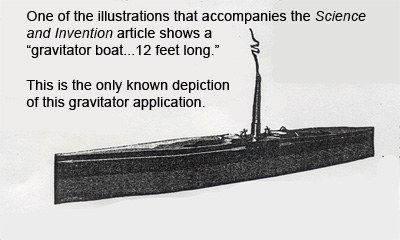
Fields in space are produced by the presence of material
bodies or electric charges. They are gravitational fields or electric fields
according to their causes. Apparently they have no connection one with the
other. This fact is substantiated by observations to the effect that
electric fields can be shielded and annulled while gravitational fields
are nearly perfectly penetrating. This dissimilarity has been the chief
hardship to those who would compose a Theory of Combination.
It required Dr. Einstein's own close study for a period of
several years to achieve the results others have sought in vain and to
announce with certainty the unitary field laws.
Einstein's field theory is purely mathematical. It is not
based on the results of any laboratory test and does not, so far as known,
predict any method by which an actual demonstration or proof may be made.
The new theory accomplishes its purpose by "rounding out" the accepted
Principles of Relativity so as to embrace electrical phenomena.
The Theory of Relativity thus supplemented represents the last
word in mathematical physics. It is most certainly a theoretical structure
of overpowering magnitude and importance. The thought involved is so far
reaching that it may be many years before the work is fully appreciated and
understood.
 Early Investigations
Early Investigations:
The writer and his colleagues anticipated the present
situation even as early as 1923, and began at that time to construct the
necessary theoretical bridge between the two then separate phenomena,
electricity and gravitation. The first actual demonstration of the relation
was made in 1924. Observations were made of the individual and combined
motions of two heavy lead balls which were suspended by wires 45 cm. apart.
The balls were given opposite electrical charges and the charges were
maintained. Sensitive optical methods were employed in measuring the
movements, and as near as could be observed the balls appeared to behave
according to the following law: "Any system of two bodies possesses a mutual
and unidirectional force (typically in the line of the bodies) which is
directly proportional to the product of the masses, directly proportional
to the potential difference and inversely proportional to the square of the
distance between them."
The peculiar result is that the gravitational field of the
Earth had no apparent connection with the experiment. The gravitational
factors entered through the consideration of the mass of the electrified
bodies.
The newly discovered force was quite obviously the resultant
physical effect of an electro-gravitational interaction. It represented the
first actual evidence of the very basic relationship. The force was named
"gravitator action" for want of a better term and the apparatus or system
of masses employed was called a "gravitator."
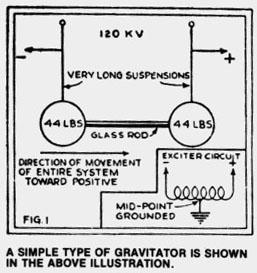
Since the time of the first test the apparatus and the methods
used have been greatly improved and simplified. Cellular "gravitators" have
taken the place of the large balls of lead. Rotating frames supporting two
and four gravitators have made possible acceleration measurements. Molecular
gravitators made of solid blocks of massive dielectric have given still
greater efficiency. Rotors and pendulums operating under oil have eliminated
atmospheric considerations as to pressure, temperature and humidity. The
disturbing effects of ionization, electron emission and pure electro-statics
have likewise been carefully analyzed and eliminated. Finally after many
years of tedious work and with refinement of methods we succeeded in
observing the gravitational variations produced by the moon and sun and much
smaller variations produced by the different planets. It is a curious fact
that the effects are most pronounced when the affecting body is in the
alignment of the differently charged elements and least pronounced when it
is at right angles.
Much of the credit for this research is due to Dr. Paul
Biefield, Director of Swazey Observatory. The writer is deeply indebted to
him for his assistance and for his many valuable and timely suggestions.
 Gravitator Action an Impulse
Gravitator Action an Impulse:
Let us take, for example, the case of a gravitator totally
immersed in oil but suspended so as to act as a pendulum and swing along the
line of its elements.
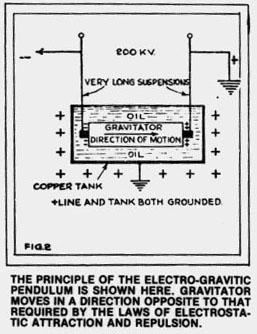
When the direct current with high voltage (75-300 kilovolts)
is applied the gravitator swings up the arc until its propulsive force
balances the force of the earth's gravity resolved to that point, then it
stops, but it does not remain there. The pendulum then gradually returns to
the vertical or starting position even while the potential is maintained.
The pendulum swings only to one side of the vertical. Less than five seconds
is required for the test pendulum to reach the maximum amplitude of the
swing but from thirty to eighty seconds are required for it to return to
zero.
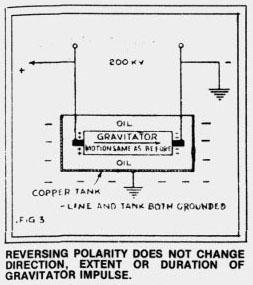
The total time or duration of the impulse varies with such
cosmic conditions as the relative position and distance of the moon, sun
and so forth. It is in no way affected by fluctuations in the supplied
voltage and averages the same for every mass or material under test. The
duration of the impulse is governed solely by the condition of the
gravitational field. It is a value which is unaffected by changes in the
experimental set-up, voltage applied or type of gravitator employed. Any
number of different kinds of gravitators operating simultaneously on widely
different voltages would reveal exactly the same impulse duration at any
instant. Over an extended period of time all gravitators would show equal
variations in the duration of the impulse.
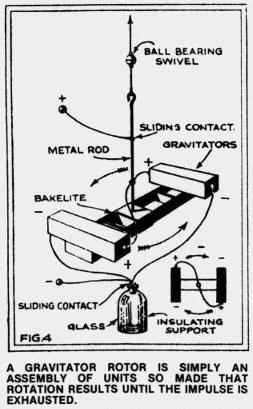
After the gravitator is once fully discharged, its impulse
exhausted, the electrical potential must be removed for at least five
minutes in order that it may recharge itself and regain its normal gravitic
condition. The effect is much like that of discharging and charging a
storage battery, except that electricity is handled in a reverse manner.
When the duration of the impulse is great the time required for complete
recharge is likewise great. The times of discharge and recharge are always
proportional. Technically speaking, the exo-gravitic rate and the
endo-gravitic rate are proportional to the gravitic capacity.

Summing up the observations of the electro-gravitic pendulum
the following characteristics are noted:
APPLIED VOLTAGE determines only the amplitude of the swing.
APPLIED AMPERAGE is only sufficient to overcome leakage and
maintain the required voltage through the losses of the dielectric. Thus
the total load approximates on 37 ten-millionths of an ampere. It apparently
has no other relation to the movement at least from the present state of
physics.
MASS of the dielectric is a factor in determining the total
energy involved in the impulse. For a given amplitude an increase in mass is
productive of an increase in the energy exhibited by the system (E = mg).
DURATION OF THE IMPULSE with electrical conditions maintained
is independent of all of the foregoing factors. It is governed solely by
external gravitational conditions, positions of the moon, sun, etc., and
represents the total energy or summation of energy values which are effective
at that instant.
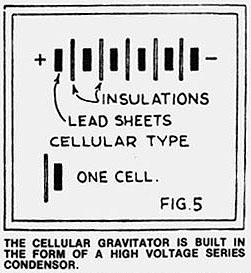
GRAVITATIONAL ENERGY LEVELS are observable as the pendulum
returns from the maximum deflection to the zero point or vertical position.
The pendulum hesitates in its return movement on definite levels or steps.
The relative position and influence of these steps vary continuously every
minute of the day. One step or energy value corresponds in effect to each
cosmic body that is influencing the electrified mass or gravitator. By
merely tracing a succession of values over a period of time a fairly
intelligible record of the paths and the relative gravitational effects of
the moon, sun, etc., may be obtained.
In general then, every material body possesses inherently
within its substance separate and distinct energy levels corresponding to
the gravitational influences of every other body. these levels are readily
revealed as the electro-gravitic impulse dies and as the total gravitic
content of the body is slowly released.
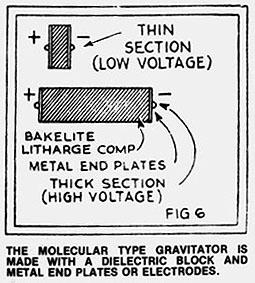
The gravitator, in all reality, is a very efficient electric
motor. Unlike other forms of motors it does not in any way involve the
principles of electromagnetism, but instead it utilizes the newer principles
of electro-gravitation. A simple gravitator has no moving parts but is
apparently capable of moving itself from within itself. it is highly
efficient for the reason that it uses no gears, shafts, propellers or
wheels in creating its motive power. It has no internal resistance and no
observable rise in temperature. Contrary to the common belief that
gravitational motors must necessarily be vertical-acting the gravitator, it
is found, acts equally well in every conceivable direction.
While the gravitator is at present primarily a scientific
instrument, perhaps even an astronomical instrument, it also is rapidly
advancing to a position of commercial value. Multi-impulse gravitators
weighing hundreds of tons may propel the ocean liners of the future. Smaller
and more concentrated units may propel automobiles and even airplanes.
Perhaps even the fantastic "space cars" and the promised visit to Mars may
be the final outcome. Who can tell?

















